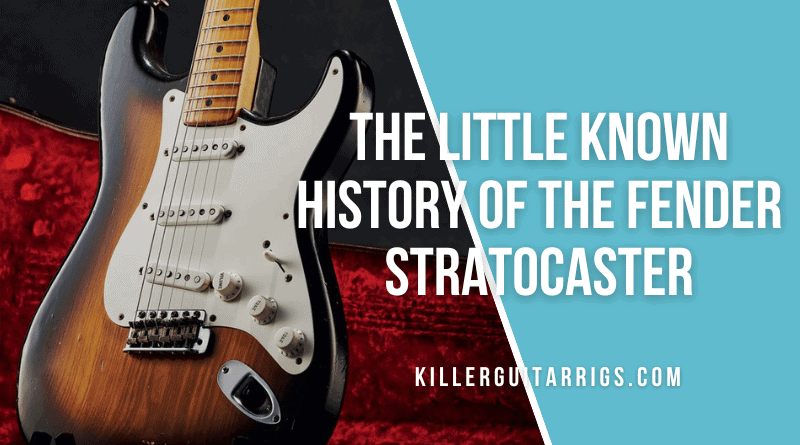The 1950s was a revolutionary time for product design. The world was getting back on its feet again after World War 2, and the “Space Race” was inspiring everything from fashion to technological advancements in all areas of manufacturing. One such example was the Fender Stratocaster.
The Stratocaster literally got its name from these world events, with Fender sales executive Don Randall (who had also named the Telecaster), saying that the space age and the lure of the stratosphere were the biggest inspirations for the, at the time, revolutionary guitar.
Since its introduction, the Strat has remained virtually unchanged in principle, and is now just as much a pop culture icon as it is a musical instrument.
In this KillerGuitarRigs Special, we’ll be paying tribute to the Fender Stratocaster, a guitar that has been in continuous production for the last 8 decades. We’ll be uncovering some of the more little known facts about this incredible and historical guitar.
Contents
- The Stratocaster Changed Fender’s Approach to Instrument Finishes
- Early Strats Were Fitted with 3 Way Pickup Selectors
- The Synchronized “Tremolo” System was Revolutionary
- The Design for the Stratocaster Was Far from Original
- The 1970s Marked a Low Point for the Stratocaster
- Pop Quiz!
- Final Thoughts on the Fender Stratocaster
The Stratocaster Changed Fender’s Approach to Instrument Finishes
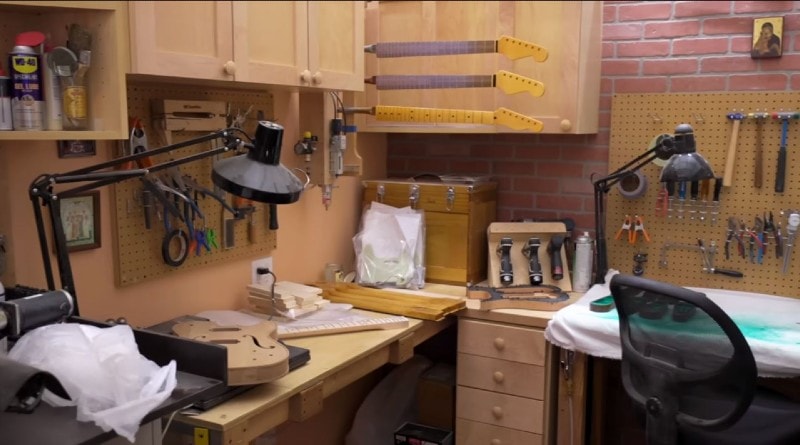
The ‘50s weren’t just a big time for Fender, this decade actually heralded the invention of many of today’s most iconic guitars, including the Gibson Les Paul. The Les Paul had been made with a number of finishes, including 2 color sunbursts, which had long been available in the Gibson lineup.
Until this point, Fender had only made their existing models, the Esquire and the Telecaster with solid finishes, but because of Gibson’s success with these colors, they decided to make the very first Strats with such a finish.
Fender used nitrocellulose lacquer (as did most manufacturers at this time), with a yellow color in the center, and graduated black around the edges. Early Strats all had ash bodies, and this sunburst finish really showed off the fantastic grain patterns of this beautiful wood.
Needless to say, the sunburst finish proved to be extremely successful, and Fender later employed it on the rest of their lineup.
Early Strats Were Fitted with 3 Way Pickup Selectors
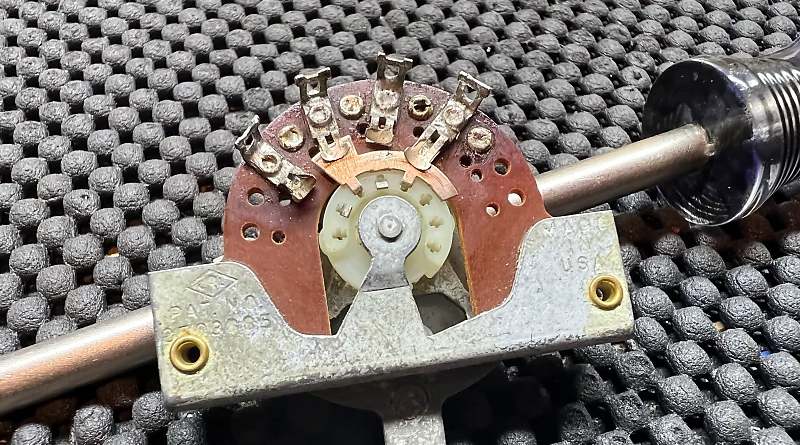
One of the biggest draws to today’s Fender Stratocaster is the sheer versatility afforded by its 5 way pickup selector switch. Modern examples can choose to individually play the neck, middle, and bridge pickups, as well as the in between positions (bridge/middle, neck/middle) – often referred to as the 2 and 4 positions. In fact, some models even have a push pull knob that allows the inclusion of the neck pickup in any position.
These middle positions produce the “quack” tone that has become so iconic with the Stratocaster.
Getting the quack wasn’t always easy, however. The original Stratocaster was made with a 3 way selector switch that only allowed players to select individual pickups. Players who wanted the quack needed to carefully place their selector switches in the middle of the slotted positions, and use matchsticks, cardboard, or pieces of paper to hold it in place.
In fact, Fender didn’t actually produce a Strat with a 5 way selector switch as standard until 1977. There was no actual difference in the wiring between this and the 5 way, and simply featured an additional 2 notches that allowed the selector to stay put.
The Synchronized “Tremolo” System was Revolutionary
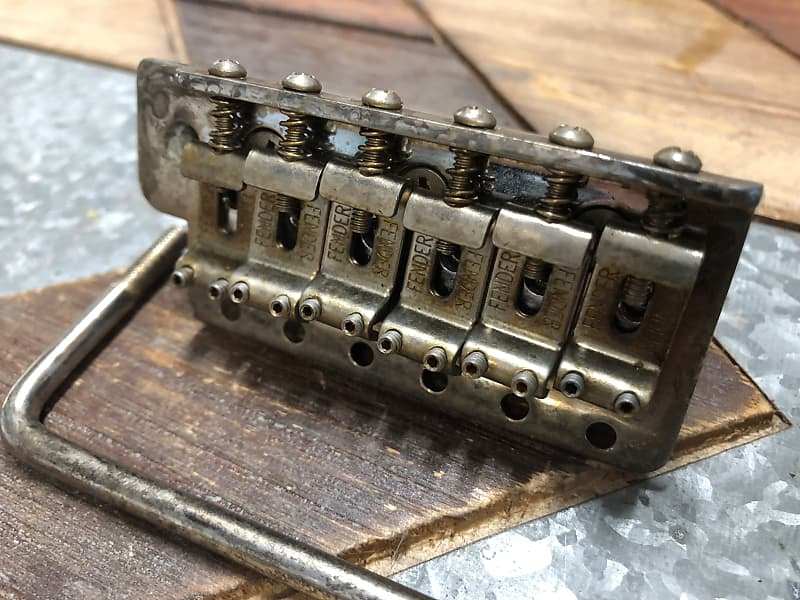
Before getting into why the Fender Synchronized Tremolo System was such a revolution, we’ll spend some time addressing the elephant in the room. It’s not a tremolo system at all.
The Fender Synchronized Tremolo System is, in fact, a vibrato bridge. Leo Fender set about improving upon the notoriously unreliable Bigsby Vibrato when he designed the Fender system, but for inexplicable reasons, he named it as the Synchronized Tremolo system. In case you’re not sure of the difference, vibrato refers to undulating changes in a note’s pitch, whereas tremolo refers to undulating changes in volume.
While the two terms are often confused with one another, it still remains an important distinction!
Now, the reason why the new Fender bridge was such an improvement! The existing vibrato systems of the day (like the Bigsby), relied on running the strings over fixed saddles, resulting in hangups, which quickly put the guitar out of tune, even after gentle use.
Fender’s new system used an entirely new bridge that moved everything, including the saddles, simultaneously (hence the “synchronized” part). Another innovation with this new vibrato system was the inclusion of adjustable springs. For the first time, players could customize the feel of their vibrato system by either adding, or removing springs from the back. It fit very much into Leo’s vision for a modular guitar system, and was lightyears ahead of the systems available on other guitars.
The Design for the Stratocaster Was Far from Original
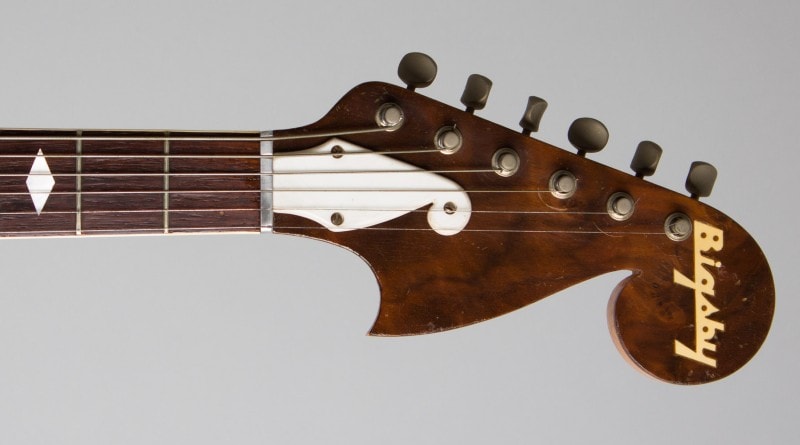
Does it really count as imitation if you steal your own designs? Fender certainly didn’t seem to think so. The design for the Stratocaster was heavily inspired by the already renowned Precision Bass.
The P Bass had staggered horns, with generous cutaways for excellent upper fret access – and this translated perfectly to the all new (but much smaller Stratocaster body. The Strat did improve upon the design quite significantly, however.
One of the biggest complaints that Fender players had was that the slab bodied guitars they had been building to date (both the Telecaster and the Precision Bass), had relatively sharp edges, and were quite uncomfortable. Fender solved this by adding a belly carve on the back of the body right in the waist area. In addition, they also rounded off the lower bass side bout, making it more comfortable for the strumming hand. This was one of the earliest examples of intentional ergonomic improvement on any guitar on the market.
Fender called this the “Original Contour Body”, and to this day, places a sticker saying the same on the headstock of the Strat.
While the Strat’s body was internally “inspired”, the headstock, on the other hand, was wholesale piracy. In fact, Fender readily admits it.
You may have heard of the Bigsby Vibrato (we’ve mentioned it several times in this special), but what you may not know is that Bigsby actually made some complete guitars. Paul Bigsby, while best known for his lap steels, actually made a few solidbody electric guitars (amazingly, only 6 are known to have ever existed, though).
These Bigsby guitars had a very elaborate scroll style headstock that Strat fans will definitely recognize. Fender took this design, simplified it slightly, and the rest is history.
The 1970s Marked a Low Point for the Stratocaster
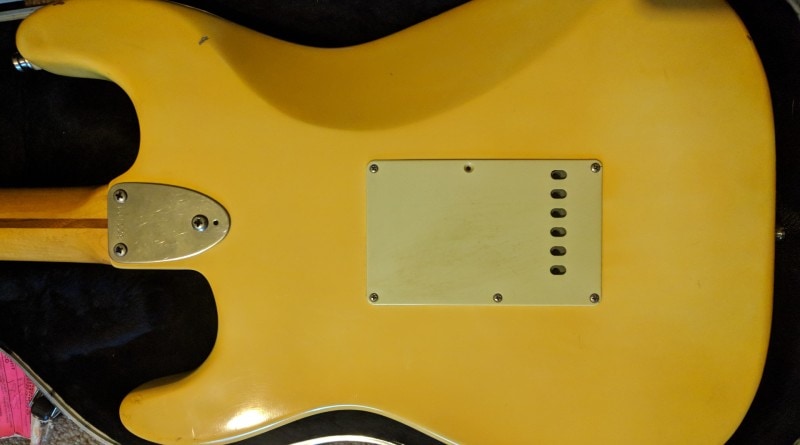
In 1965, Leo Fender sold the company to CBS (yes, the TV network) for an (at the time) astronomical $13 million. CBS ushered in a whole raft of changes, but unfortunately, shortly after the takeover quality began to decline, and by the mid ‘70s, Fender guitars, including the Strat, were notoriously poor.
There were several updates to the Stratocaster during this period, most notably, the replacement of the rectangular 4 bolt neck plate with a triangular 3 bolt neck plate. The new neck plate featured micro tilt adjustment, intended to make it easier for players to adjust the neck angle. Unfortunately for Fender, this change occurred just as the quality of the guitars hit rock bottom. Strats of this time were infamous for having wobbly necks, and naturally, players made an assumption that the new 3 bolt neck plate was the cause of the problems.
In fact, it was almost entirely caused by the fact that due to new manufacturing processes, the neck pockets were being cut too big. The then head of sales at Fender, Dale Hyatt, is quoted as saying, “they blamed the new three bolt neck but it wasn’t that. You could have put six bolts in it and it still would have moved”.
One of the other unpopular changes during this period was the change in finishing. Until this point, Strats had been finished, as standard, in a beautiful, thin nitrocellulose lacquer. Under CBS leadership, this all changed, and Fender started finishing their guitars with dozens of layers of a thick, polyester lacquer. Not only did this affect the looks and feel, many claim it numbed the tone by impacting the natural resonance of the ash body.
Pop Quiz!
Do you know why it is that other brands seem to be able to just use the Stratocaster shape without even slightly modifying it?
Well, in 2004 Fender’s copyright on the shape of the Telecaster, Precision Bass, and the Stratocaster expired. They petitioned to extend, but in 2009, after 5 years of litigation, and after submitting tens of thousands of pieces of evidence to their claim, a US court ruled that other makers had been copying the Strat design for so long, that it had become the de facto image of a generic electric guitar.
The Trademark Trial and Appeal Board is quoted as saying “In fact, in the case of the [Stratocaster] body outline, this configuration is so common that it is depicted as a generic electric guitar in a dictionary.”
Final Thoughts on the Fender Stratocaster
Even though it’s often thought of as being a bit vanilla these days, the Stratocaster is still one of the must have models in any collection. Some of the most revered guitarists in history have made the Strat their weapon of choice, and its iconic tones have helped to shape the face of music as we know it today.
It has influenced countless other guitars over its almost 70 year lifespan, and we have no doubt it will continue to do so for decades to come.

